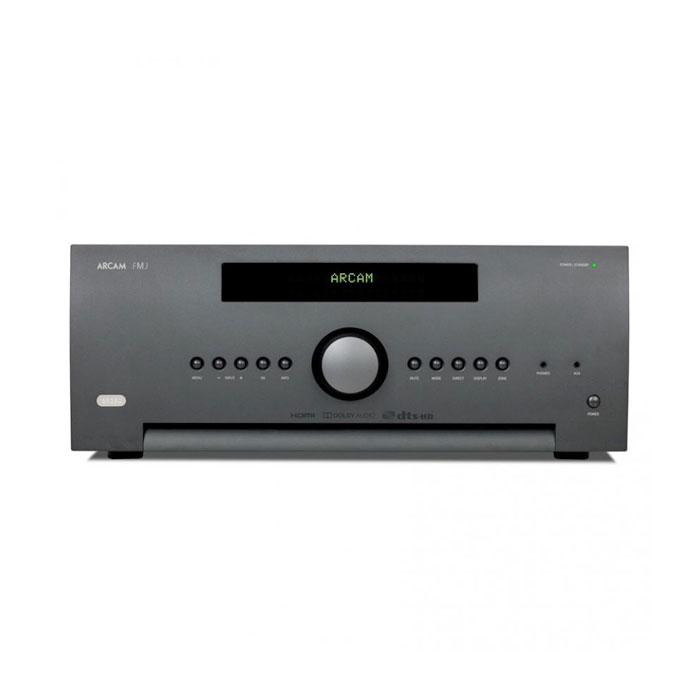
ARCAM SR250 STEREO RECEIVER REVIEW
Arcam's top of the line Stereo Receiver.

PRICE
$2499
THE HIGH NOTES
- Class G Amp Section
- Dirac Room Correction
- State of the Art DACs
Company & Product Overview
Arcam has long been a highly respected brand in the world of British HiFi. They began when two engineering students from Cambridge University got together and formed a company named “Amplification and Recording Cambridge”. They later changed this to Arcam. Their A60, a small integrated amplifier, was their very first product and it went on to sell over 30,000 units.
Audio Advice became an Arcam dealer in the early 1990’s. A factory representative from the UK came over and set up their Alpha 9 integrated amp in our store. We had it paired up with a fairly inexpensive pair of B&W speakers. The sound we heard was warm, rich, yet very clean with tons of dynamics. We were sold right then and became a dealer on the spot! Over 25 years later, Arcam’s great sounding audio products are on the shelves of Audio Advice.
Today’s review is on the Arcam SR250 Stereo Receiver, Arcam's top of the line stereo receiver. The term stereo receiver may not seem that exciting in today’s world of home theater, but as you shall see when we get into all the features inside the SR250, this is not your typical stereo receiver!
Design & Build Quality
While the SR250 only has two channels of amplification on board, it has many of the features you would find in a top of the line home theater receiver. It is designed to be the heart of a system for someone who has two great speakers but wants to incorporate video sources into their system. The connections available on the SR250 actually surpass many tops of the line home theater receivers!
The massive amplifier section of the SR250 is powered by a technology known as Class G. We will explain this in more detail in the tech section, but Class G is one of the best ways we know of to make an amplifier. Another great piece of tech found in the SR250 is Dirac room correction, also covered in the tech section.
The front panel of the SR250 is a matte grey finish with a few buttons to access the sources and menu control. One large knob is right in the center under the multi-function display. The fit and finish are what you would expect from a high-end piece of gear with a very solid feel. On the left side of the front panel, you’ll find a mini headphone jack and a mini-plug RCA input.
When you get ready to pull the SR250 out of the box, bend your knees as it weighs in at over 33 pounds. A lot of heft is always a good sign of a large power supply lurking under the cover, which is the case with the SR250.
Build quality on the rear panel connections is very typical of a higher-end home theater receiver. You’ll get very solid binding posts with the typical board-mounted RCA inputs and outputs. However, the four coax digital inputs are of the chassis mount type and are beefier than the other connections.
Overall, the SR250 is built very well with a simple and clean exterior. The reason we love the SR250 is all of the tech hiding out under the cover that makes this receiver sound fantastic!
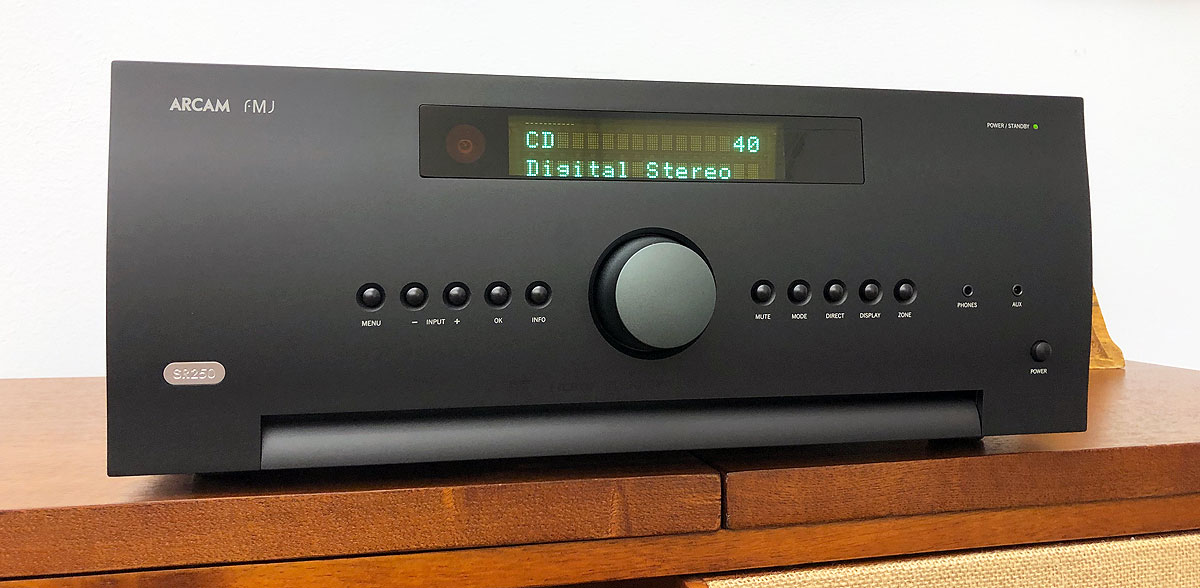
Features & Technology
The connection and output options on the SR250 are very impressive, allowing it to fit into many different types of system configurations. There are 8 analog audio inputs, 4 coax digital inputs, 2 Toslink digital inputs, and 7 HDMI inputs. The HDMI inputs all support the latest HDMI 2.2 technology.
You’ll get a preamp out if you choose to add a bigger amp later (although we are not sure why you would want to bypass the great amp in the SR250). You also have two subwoofer outputs. In addition, you get a zone 2 set of preamp outs for running another room. There are even 3 HDMI outputs, one for the main zone, a second one that follows the main zone, and a zone 2. The main HDMI output also supports audio return channel.
There are rear panel IR inputs for both the main zone and zone 2, along with 12volt trigger controls for each zone. For home control systems there is the option of using either IP or RS232 control. You will also be able to access music on your network through its UPnP capability or use the included Spotify Connect technology. There is even a FM tuner built in and when on the right radio station, sounds really good too!
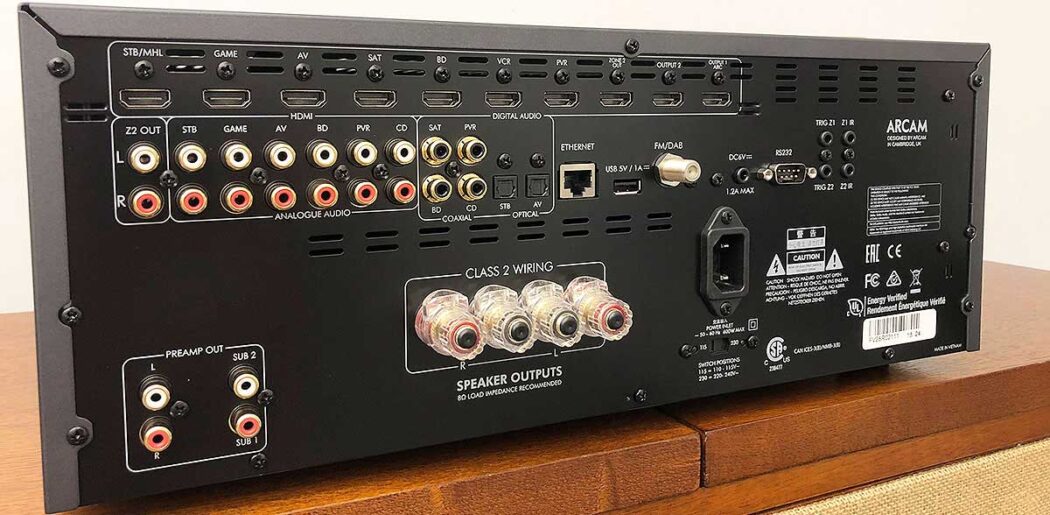
Even though this is just a two-channel stereo unit, it supports all the latest in Dolby formats and will simply downmix them into two channels for your system. We also love the fact it has bass management which will let you set smaller bookshelf or limited tower speakers to small and allow you to augment them with one or two subwoofers.
All of these features are pretty much what you would expect to find on a big home theater receiver, but what sets the SR250 apart is its sound. The first step in great sound from your HDMI, UPnP, and other digital sources is a great DAC section. Arcam chose the Cirrus Logic CS42528 for its DAC. This is a popular DAC in the world of very high-performance audio. One quick way to tell the quality level of a DAC is to simply do a Google search for the part number. You’ll typically see bulk prices for the DAC chip and you’ll find out that most DAC’s used in home audio products are under a couple of bucks from a raw parts cost. The Cirrus Logic CS42528 DAC, however, sells for almost $12 due to its much higher performance capability. If you do a little snooping around on this DAC, you’ll find it shows up in a lot of other very high-end audio products. Needless to say, its one great sounding DAC that supports audio sampling rates up to 192k.
Arcam features a Class G amplifier section in the SR250. This amp is rated at 120 watts per channel into an eight-ohm load and it will almost double down to 210 watts per channel into a four-ohm load. Arcam has a couple of other products that incorporate their Class G technology; however, we feel it is somewhat misunderstood as to just how good it is!
In basic terms, musical waveforms have a top and bottom half. Each half requires an output device in the amplifier section. When the signal switches from one device to the other, distortion can get into the sound. This happens since the output devices are turning on and off. In the perfect amplifier, they would never turn off which would eliminate the switching distortion as it’s called. There is a design like this, and it's called Class A. A pure Class A amplifier might only produce 20-30 watts and weigh in at 50-100 pounds. When those output devices are on all the time, a lot of heat is generated. Some pure Class A amps can make a room very hot! These types of amplifiers are still made, but they are limited to the ultimate purest who is willing to put up with both the heat and size of the amp.
Class AB is used in most good receivers and amplifiers today. It is an offshoot of Class A, but the output devices turn off to reduce heat build-up. Circuitry is added to reduce the switching distortion. Class AB is not as pure as Class A, but it is a great option for lots of power and a smaller, more efficient package.
Class D is a more recent design, and at first take, you might think the D stands for digital, but it actually does not. This type of design is almost 100% efficient, gives off very little heat, and takes up less space. So far it sounds like the ideal amp design, right? For some situations, like touring sound where you need thousands of watts in something portable, it is ideal. On the opposite end of the spectrum, it also can be so small it is used in hearing aids and portable speakers. The one catch to Class D is its ultimate audio quality. Many listeners think it has a harsh, somewhat tinny sound, and we agree. You don’t want to spend thousands on a new amp and come out with harsh sound, you want it pure, smooth, and dynamic.
Ok, we have Class A, AB, D, and they have each gotten progressively worse, right? How can Class G be any good? We are not sure who came up with the naming scheme for Class G, but we think it is why many people do not consider it. In reality, Class G is actually the best of both Class A and Class AB combined. The first Class G amp actually came out in 1977 and was from Hitachi. Way back then, that was one sweet sounding amplifier!
If you were to put a meter on your amp and measure how much power it uses at low to moderate listening levels, you would find it is only using a couple of watts of power. If you have fairly efficient speakers, you may never get past 5 watts of power 90% of the time. What if there was a design that could run at pure Class A for this type of power consumption, then switch over to Class AB when you needed the extra horsepower? That is exactly what Class G does! The “G” should stand for Class “Great”. For most of your listening, the amp runs at the best possible power mode, pure Class A. It really is a wonderful idea on how to design a power amp.
The best design without great support circuitry will not sound great, but Arcam has done a remarkable job on the SR250. If you pop the cover you will find a huge toroidal power supply that supports the Class G power amp inside. The sound this amp produces is super smooth and sweet, yet when a demanding passage comes along, it delivers all the dynamics!
Arcam could have stopped right there and had a winner of a design, but they went one step further and really put the icing on the cake with our favorite room correction technology, Dirac!
It used to be that room EQ was frowned upon by audiophiles as the way it was implemented caused more audio issues than it fixed. As processing power got better and less expensive, new types of room EQ were developed. We first experienced Dirac in 2014 when we tested the Datasat RS20i, a $20k+ home theater processor. The improvement in sound was far beyond what we expected.
If you ask any audio engineer what has the biggest impact on how your system sounds, they will all tell you it is the room. The physical dimensions of every room effect frequency response and the timing of how the sound arrives to our ears. Dirac was developed about 15 years ago by a group of Ph.D. engineering students at Uppsala University in Sweden. Dirac not only addresses frequency problems caused by the room but also impulse abnormalities that come from the shape of your room. When Dirac is properly calibrated for your room, it will dramatically improve your sound. We have been shocked at the differences we have heard!
We were really intrigued when we saw Arcam was going to have Dirac in a two channel all in one unit. Up until now, it had only been available in home theater processors.
When we first tested the SR250, we used the microphone Arcam included for the measurements. We were extremely disappointed in the results and felt it sounded worse with Dirac engaged. Well, it turns out, the old adage of garbage in, garbage out applies to Dirac! We tried again with the microphone from Datasat and viola, we heard the improvements we expected. Arcam has since improved the microphone, but we still suggest an aftermarket model. MiniDSP makes an excellent one for under $100.
Another very cool part of the Dirac equation is the fact that since it is software based, you’ll be able to download the latest version once improvements are made, recalibrate your system and get even better sound! You cannot beat that.
We hope you can see why we feel the SR250 represents such a great audio value even at its price point. When you combine state of the art DACs with pure Class G power and add in Dirac room correction, you have one heck of a product.
Performance
For our testing we decided to use the Revel 208 speakers. These are large floor standing speakers that sell for $5,000 a pair, which seemed to be a good match for an amp of this quality. We connected up the Arcam CDS50 as our source using its coax digital out so we could take advantage of the DAC’s inside the SR250.
Before we did the Dirac calibration, we tried a couple of cuts on the SR250 to see how it did without any EQ involved. Our first one was “Lay Me Down” from the Crosby Nash album of 2004. This track can have a huge soundstage if the system is done right and we were certainly experiencing this with the SR250. The next cut was another classic, “Handle with Care” from the first Traveling Wilburys album. On a great system the guitars on this sound spectacular.
The SR250 had a very sweet sound through the Revels on both of these tracks. The great DAC’s and Class G amp were producing a sound that was totally free of fatigue and felt super effortless. We have noticed that once your ears get used to what a system sounds like that has had room correction applied properly, the bass is usually not super impressive until you apply room correction.
We then used the Dirac Live software to apply room correction. As we suggested earlier, we highly advise you to use a better microphone than the one included with the unit. For this test, we used the one Datasat recommends. Since we were only doing two speakers, this was a pretty quick exercise. For our target curve, we applied the Harman curve, which we have found to be a great starting point.
The room we were doing this in is probably a typical room, being about 14 ft by 18 ft. Just like we thought would happen, the improvement in sound once Dirac was applied was nothing short of amazing. The bass became far more articulate, which in turn opened up both the midrange and treble. Sound staging, especially on the Crosby Nash cut, got much bigger. Overall, a huge improvement!
Overall Recommendation
Arcam has combined three of our favorite things into one heck of a great package: Class G power, great DACs, and the power of Dirac room correction. When you combine all these into one unit, the result is far greater than the sum of the parts. We’d suggest if you have speakers in the $2,000 or greater price range, the Arcam SR250 will make them sound better than you ever dreamed. The positive impact Dirac has in most rooms will open up your ears!
HIGH NOTES UNPACKED
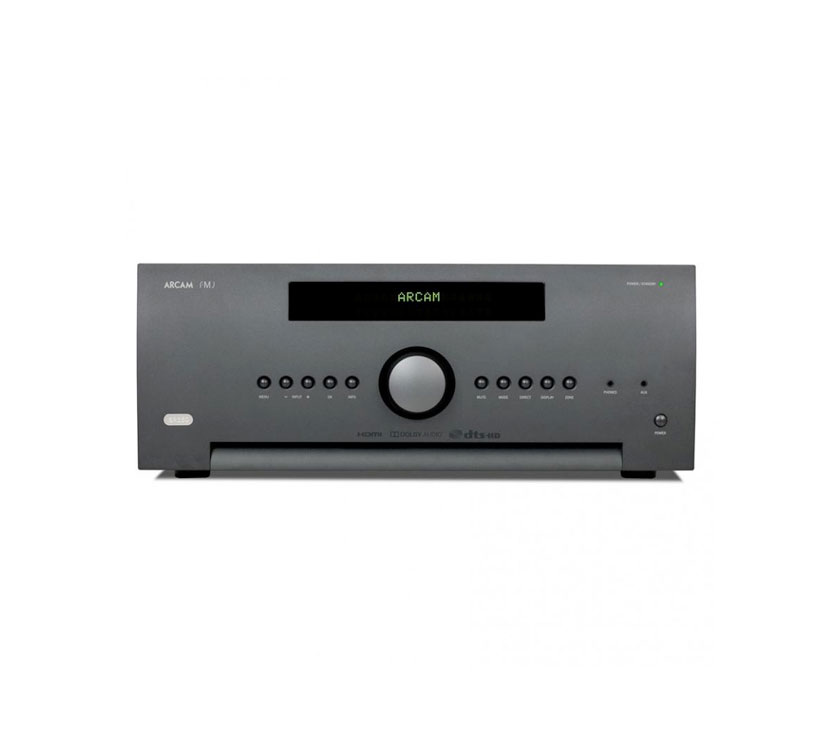
Class G Amp Section
You will hear how good Class G can be in the SR250. The sound is smooth and sweet with all of the details and great dynamic punch.
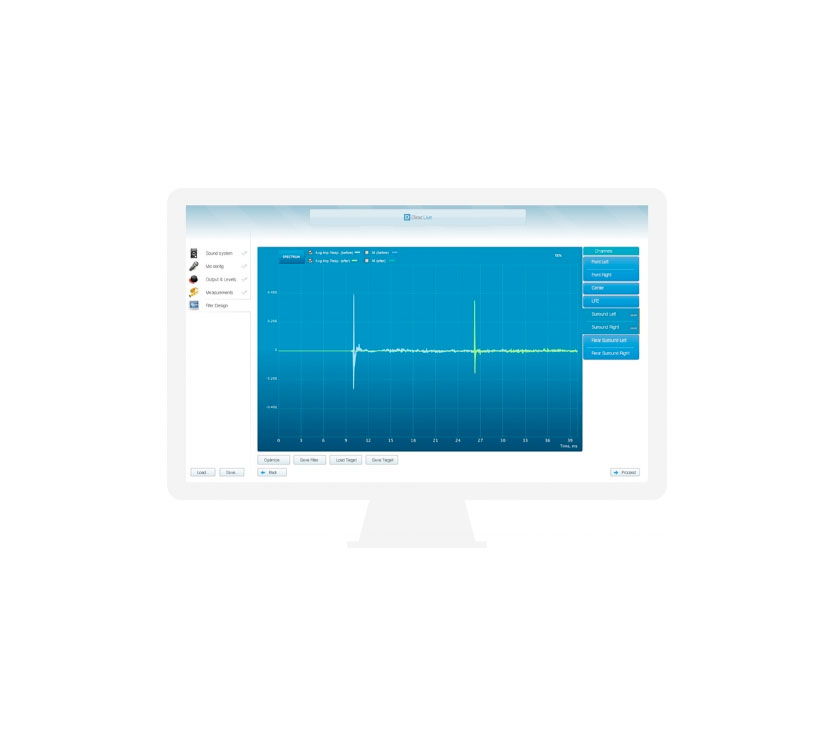
Dirac Room Correction
Dirac is our favorite room correction software and it is great to see it implemented so well in the SR250.

State of the Art DACs
Nowadays, everything gets processed through DAC’s. Arcam picked some of the best on the market for the SR250 and it shows in its sweet, natural sound.
Recommended Products:
-
 Revel F208 3-Way Floorstanding Tower Loudspeaker - Black - Each
Special Price $1,925.00 Regular Price $2,750.00
Revel F208 3-Way Floorstanding Tower Loudspeaker - Black - Each
Special Price $1,925.00 Regular Price $2,750.00


